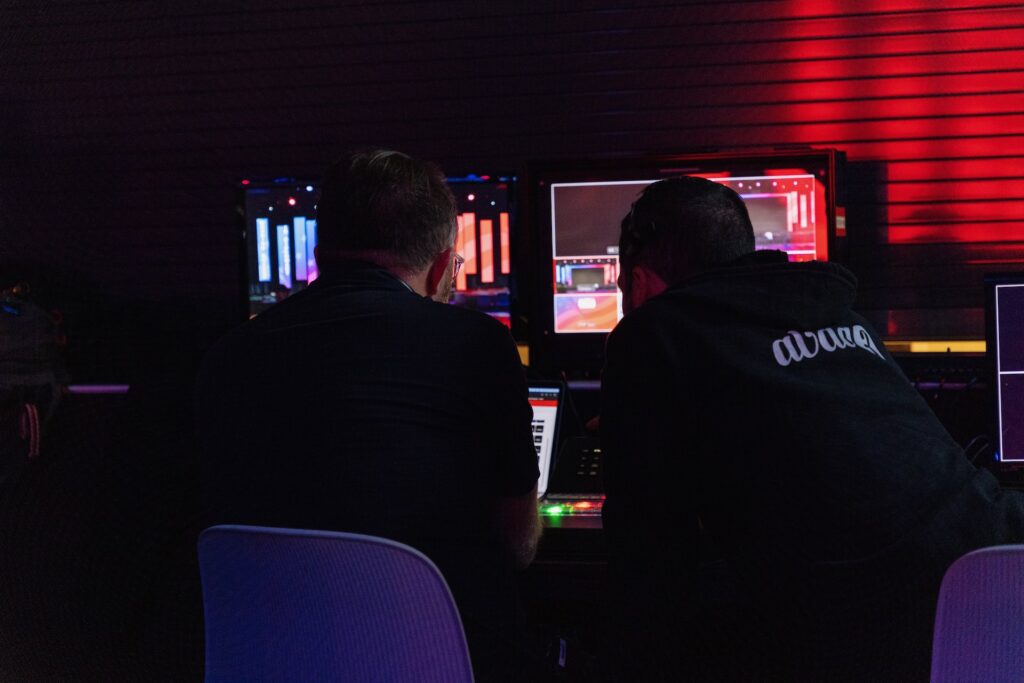The unfortunate truth for most planners is that the most stressful day of the year is the actual day of their event. It doesn’t have to be this way. There are a few tools you can use again and again to organize your event. Whether your event is across the country or a mile down the road, these key components will leave you stress-free and feeling prepared for any event scenario.
Why the Right Production Team Matters for Your Big Event
Production is the largest piece of the event-planning puzzle. The attendees you’ve flown in, the VIPs you’ve booked, and the venue simply don’t matter if your event production partner is lacking. An event is based on the premise of capturing attendees’ attention and conveying a message — if this audience cannot see your speakers or hear their message, the event is a failure.
The stakes are relative to each unique situation but are always high. While important, having the proper production gear in the room is not enough. The real key is having the right people control the gear. The key to a great event lies within the technical details and those who control them. Here are the 4 steps to successful event planning:

1: Recognize and Accept the Stakes
Success for an event is not a singular concept, it is measured differently by each vendor, presenter, client, venue, and attendee. From an AV standpoint, there are some obvious criteria: If a technical problem did arise during the show, was it handled well and solved quickly? Was everyone able to see and hear the message? Did the transitions flow or was it stop-and-go?
You should expect more from the basic criteria in the room though. It’s not just about the two-hour event, it’s also about the months of planning and hours of pre-production where the AV company should act as an extension of your team. No matter how compressed or extended the planning timeline may be, there is a unifying arc that you can, and should, plan on.
Recognizing the stakes is the first step in setting expectations internally and with third parties.

2: Set Expectations For Your Event
We all know that presentations will change, the program will be modified, and external factors will influence internal decisions. Plan on these inevitabilities, limit them with deadlines, and build a roadmap where everyone knows the timeline.
Planning is an ambiguous word that means different things to different people. The basic understanding is that arrangements will be made in advance for the desired outcome. The final outcome may not be what we had planned for, but the simple act of having a systematic approach to a goal helps ensure our success.
Set expectations early so that 3 months into planning, your AV partner, the venue, and the client are all in sync. In the absence of a proactive planner, each party will follow its own timeline which can lead to a build-up of potential problems with no solutions come event day.

3: Manage the Macro Agendas
By following the previous two steps, you’ve already set the expectations for your event and communicated them to vendors on the front end.
To give an example of a macro-level agenda: At avad3 we submit a rough overview of our ideal project schedule. This includes a timeline for future meetings, site visits, client calls, all-party calls, and revision due dates. We know that the floor plan will change a dozen or more times throughout the planning process. We also know that power, rigging, and other factors not only provide limitations to what that layout can be but also directly affect other involved parties.
Having a proactive, planned approach to address each party’s needs is a big step in guiding everyone to success. This allows your AV partner and other vendors to be aware of changes and how they may affect their approach. This process can take a lot of work depending on the vendors, venue, and client, but it is worth the effort.
4: Manage the Micro Agendas
The micro-level planning is where the real collaboration and big, key decisions get made. When you set meetings with clear expectations for each party, you net positive results. Providing a clear outline of what the agenda is for each meeting creates a different dynamic; one that pushes your AV partner, venue, or other vendors to come up with recommendations or make decisions that specifically move the project forward.
An agenda also creates tangible stakes for your vendors and allows them to play out negative outcomes if they choose not to participate. For instance, there could be program changes that affect production, seating layout, catering, decor, etc. The possibilities are endless. If all the characters know that these details are being decided in a particular meeting, then they’ll be more incentivized to take part and have their say. This increases efficiency for everyone and results in less wasted time.
When each party knows what is at stake by not participating, they bring their insight and expertise into play, addressing the items and answering questions. One meeting that nets positive results is worth more than 10 meetings where nothing gets decided.
The 4 Steps to Success
Getting all stakeholders on the same page for an event is not a simple task. The hours of setup where each party comes together after months of planning to execute a unified vision make all the preceding processes worth the effort. Follow these steps to help ensure your event’s success:
- Recognize all the hard work and preparation from each vendor.
- Set expectations from the very beginning.
- Set agendas at the macro and micro levels.
- Establish tangible, achievable goals that limit waste.

These steps ensure all the checkboxes on your project have been accounted for on the day of your event. As you slowly fill up the event space with the physical set pieces, you are giving reality to a concept that has been stamped with approval by all parties.
Success is achievable if you’ve done the work. When expectations are set and your vendors are aligned, rest assured they are aligned because you led the way.
